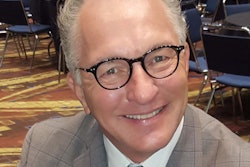
When you are confronted with a patient treatment dilemma, where do you turn for information to guide your treatment? Geoffrey A. Thompson, DDS, told attendees at the recent 2018 Chicago Dental Society Midwinter Meeting that applying evidence-based dentistry (EBD) can help answer your treatment questions.
Dr. Thompson defined evidence-based dentistry as the integration of relevant scientific evidence into an assessment of a clinical finding, which could be modified by clinical experience and expertise.
"The message is that EBD assists with decision-making," he said in his presentation, titled "Is what you know really true?"
Dr. Thompson is an associate professor and the graduate program director for prosthodontics at the Marquette University School of Dentistry in Milwaukee.
Clinical question
Dr. Thompson equated finding an answer to a clinical treatment question to hunting for a needle in a haystack. Evidence-based dentistry starts with writing a well-defined clinical question.
"What is the question you are trying to answer?" he asked. "Formulating a question is like describing the needle."
Dr. Thompson begins by formulating the clinical question he wishes to solve, which he noted could be about a particular therapy or prognosis. He phrases his questions into a PICO format: patient, population, or problem; intervention; comparison; and outcome.
Using the example of a patient who needs a crown for an implant, he shared his PICO outline:
- Problem: A patient needs a crown for an implant.
- Intervention: Which cement has the best clinical outcomes?
- Comparison: Are there options other than cement?
- Outcome: Which treatment leads to the best long-term peri-implant health?
To begin to answer this question, you need information, he said. Dr. Thompson asked attendees where they get their clinical information. Responses included what he called "quick sources of information," such as YouTube, Google searches, and talking with colleagues. The results of those searches may not have the clinical expertise a dentist needs, he said. The next level up in terms of clinical usefulness is the printed publications mailed to practices.
"But often these publications aren't peer-reviewed, and they contain a lot of material from manufacturers," Dr. Thompson said.
Then he noted that specialty academies, such as the American Academy of Periodontology and American Academy of Pediatric Dentistry, publish clinical information or guidelines.
"Compared with these other sources, academies are probably better sources of useful information," Dr. Thompson said.
Then there are peer-reviewed journals. But how do you access this information? Using a dental school's library to read journals is one possibility, he suggested. But if you don't have hours to spend in a library's stacks, he recommended using individual journal sites or the PubMed site from the National Center for Biotechnology Information.
Once you get to PubMed, however, you have to be able to search for useful information. Dr. Thompson detailed multiple methods of using specific search terms. Using the implant example from above, he showed how using certain search parameters can help eliminate animal studies or those in a language other than English, for instance.
Then he addressed a common issue for many practitioners: the time involved in keeping up with journal reading. Dr. Thompson recommended the Cochrane Database of Systematic Reviews to serve as a type of executive summary. He walked the audience through several relevant Cochrane reviews on various implant topics.
Levels of evidence
After you've located the relevant material, understanding the information is critical. When is a result important and when does it not have relevance? Dr. Thompson said that he is asked by both students and colleagues about the importance of the phrases "significant" and "clinically significant" in peer-reviewed studies.
"Significant means the relationship between two or more variables is not likely to have happened by chance," Dr. Thompson said. "Clinically significant is when an observation is measurable and can affect daily life."
Another issue that often confounds researchers and readers, he said, was that not all systematic reviews result in a useful outcome. He ended his presentation by pointing out one of the crucial, but sometimes frustrating, facts of clinical research -- that a lack of evidence for one result does not mean the opposite is true.
"A lack of evidence does not constitute support for the alternative," Dr. Thompson noted. "It means that you just don't know."


















